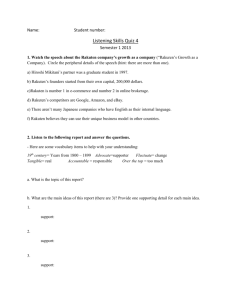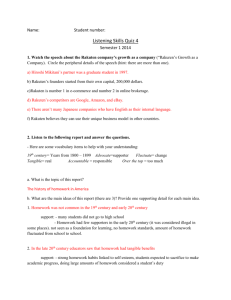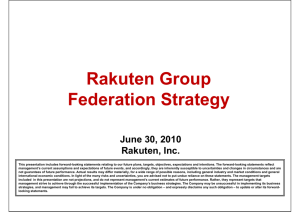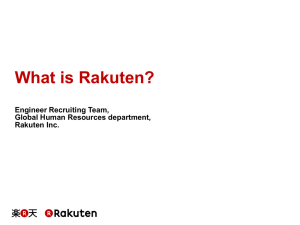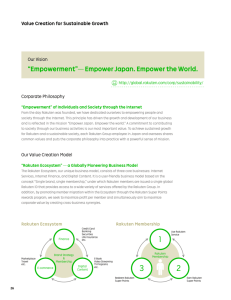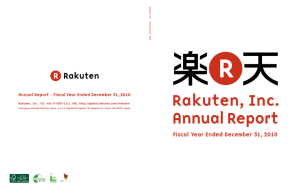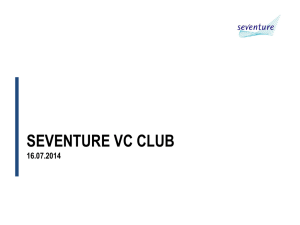Rakuten_Tsutaya
advertisement
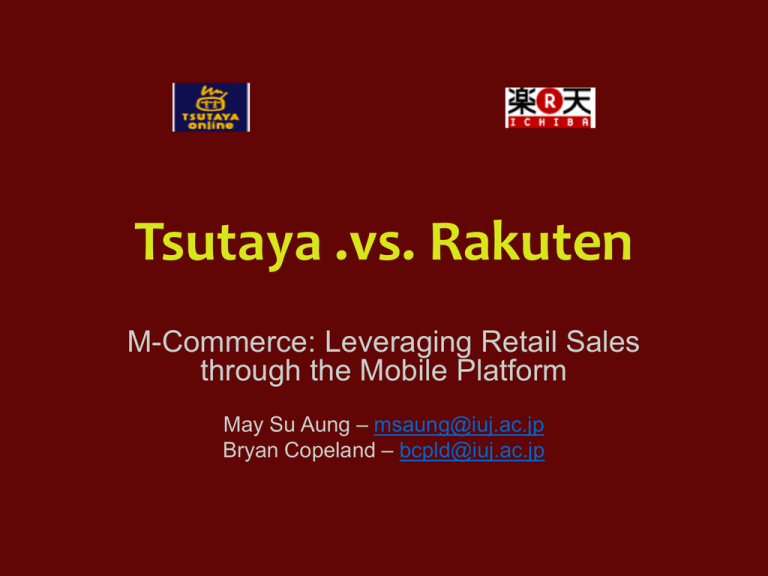
Tsutaya .vs. Rakuten M-Commerce: Leveraging Retail Sales through the Mobile Platform May Su Aung – msaung@iuj.ac.jp Bryan Copeland – bcpld@iuj.ac.jp TSUTAYA: Profile Corporate Headquarters Tokyo Established 1983 Employees/TOL* 100 Subscribers/TOL* 18.55 million Wireless technology i-Mode Movie Mail, TOL (mobile) LinkShare Parent company Culture Convenience Club Ltd (CCC includes Tsutaya and TOL) Net Sales: 3,043 million ¥ Ordinary Income: 579 million ¥ Net Income: 436 million ¥ * TOL – Tsutaya Online ** Estimated, year ended March-to-March, 2006 fiscal year; based on $1 = ¥132.06 (TOL - 1999) Approach to Mobility How does Tsutaya do it? • In 1994, CCC built a sizeable customer database • Maintain a dynamic, always-on picture of individual entertainment tastes and preferences and personalize product offerings by combining data with mobility via iMode service. How does it all work for the consumer? • TOL*, Tsutaya’s wireless i-Mode site, email consumer whenever the next release of the brand which consumer bought last time is available (or notify about clearance sales) *Case Study -- Tsutaya, a Tokyo Video Store, Goes Mobile: http://www.cioinsight.com/c/a/Past-News/Case-Study-Tsutaya-a-Tokyo-Video-Store-Goes-Mobile/ Business Strategy Store Development Strategy Bringing the 3000-Store Vision to Reality – The market radius for its retail locations: a 10 minute customer destination – They envision the potential to develop and open 3,000 stores in Japan by assuming that one TSUTAYA location exists for every 40,000 citizens. Enhanced IT to Support Store Operations • The CCC has developed a number of information technologies (IT) – To support operations, including the (AMS) – To analyze daily and hourly product movement at each store – To execute rental product orders at franchise headquarters on behalf of franchisees. • The CCC connected all stores to franchise headquarters with a knowledge-sharing system called TSUTAYA NAVI, an IT platform for creating & sharing insights to support the resolution of store operating concerns. Clicks & Mortar (C & M) • To generate synergies between physical TSUTAYA in-store services and the Internet entertainment portal (TOL). • Provide a Marketing function: TSUTAYA online, retail customers and TSUTAYA stores are directly connected via Internet. • This connection, both pinpointed and immediate, provides a marketing function that other companies do not possess. Monthly Sales & Membership Member Growth (Customer Acquisition Strategy) • 60% of 19-year-olds in Japan are "active Tsutaya members” Market Share (FY2005) Share % in parentheses: Unit billion yen RAKUTEN – Profile Corporate Headquarters Roppongi Hills, Tokyo Year founded 1997 (RA - 2003) Employees/RA 200 Subscribers/RA 17.3 Million* Wireless technology i-Mode (DoCoMo partnership) EZWeb, Yahoo! Rakuten Auctions, Portal shops Parent company Independent Net Sales: 33,636 million ¥** Ordinary Income: 6,937 million ¥** Net Income: 3,731 million ¥** * ALL Raktuen Divisions ** ALL Rakuten Divisions; Estimated, year ended March-to-March, 2006 fiscal year; based on $1 = ¥132.06 Rakuten – Mobile Strategy • Eyeing mobile auction market • Partnership with NTT DoCoMo on Rakuoku • Spin-off of Rakuten Auctions on the Mobile • DoCoMo has a 40% stake (4.2 billion 円) Case Analysis – Rakuten Ichiba: http://www.slideshare.net/icestorm/case-analysis-rakuten Rakuten – Mobile Storefront Rakuten – Financial Highlights Online Auction Market Share • Travel Bookings via Mobile Phone Rakuten 16% Other NetPrice 2.9% 0.1% Yahoo! Japan 81% Mobile Auction Market Share Rakuten 18% Yahoo! Japan 17% Other 1% NetPrice 64% Rakuten – Business Model Rakuten – Operating Margin Rakuten – Mobile Future • Pushing Rakuten Auctions on the Mobile • Tie-up talks with Tokyo Broadcasting Systems, Inc. (TBS); Internet TV negotiations • M-commerce, focused on: – – – – – Recommendation technology Captivating Contents Product-placements Ad Relevancy Increased Auction traffic/sales
